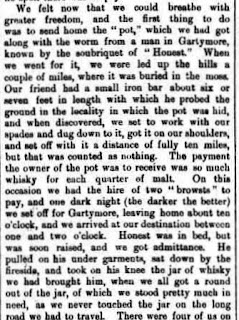Sending Home the Pot
“We
felt now that we could breathe with greater freedom, and the first thing to do
was to send home the “pot,” which we had got along with the worm from a man in
Gartymore, known by the soubriquet of “Honest.” When we went for it, we were
led up the hill a couple of miles, where it was buried in the moss. Our friend
had a small iron bar about six or seven feet in length with which he probed the
ground in the locality in which the pot was hid, and when discovered, we set to
work with our spades and dug down to it, got it on our shoulders, and set off
with it a distance of fully ten miles, but that was counted as nothing”.
Set off for Gartymore
“The
payment the owner of the pot was to receive was so much whisky for each quarter
of malt. On this occasion we had the hire of two “browsts” to pay, and one dark
night (the darker the better) we set off for Gartymore, leaving home about ten
o’clock. Honest was in bed, but was soon raised, and we got admittance. He
pulled on his undergarments, sat down by the fireside, and took on his knee a jar
of whisky we had brought him, when we all got a round out of the jar, of which
we stood pretty much in need, as we never touched the jar on the long road we
had to travel. There were four of us on the expedition, and whether from the
superior quality of the whisky we brought, or from a good Honest heart in
dealing it liberally round, I will not venture to say, but it had a very marked
effect on the company”.
 |
| Looking towards a ruined croft above Gartymore, |
Generous-hearted Honest
“The jar was laid down on its side on the good man’s knee oftener than once ere we left, and I believe it would have been a much easier task to carry it back to Badbea than to bring it up to Gartymore. Be that as it may, there was not much cold about our hearts when we left the house of generous-hearted Honest, and our animation showed itself in several odd positions in which the Gartymore folks found their carts next morning. We dragged our weary limbs along the best way we could, and arrived home in due time”.
 |
|
To Contend With Little Source: www.ltscotland.org.uk
|
To Helmsdale
“The
next matter to consider was to dispose of the whisky, most of which we sold to
private parties. A fishcurer in Helmsdale was the purchaser of several gallons
for his private use, and for which we received 9s per gallon. This was another
trip across the Ord in the dead hour of night, but which was unattended with
anything striking”.
Forced to it
“This
closed the era of Smuggling in Badbea, and while there was not another place in
broad Scotland, according to the population, where there was more of that trade
carried on, there was not another place in Scotland where less vice existed.
Smuggling was not engaged in from lawlessness or from choice. The people were
forced to it, as the only means by which they could make a pound or two to meet
the necessities of their households, as they were crushed to death by tyranny
and poverty”.
My Comments:
The small crofting community of Gartymore, near Helmsdale,
was created in the early 19th century at the time of the Sutherland clearances.
Evicted people had been allocated small pieces of land, and as the settlement was
very near the coast it was expected they would take up fishing but they
continued to live as crofters. So Gartymore
was very like Badbea in many respects. It is clear from Alexander Gunn’s story
that there was a feeling of mutual trust and support between the Badbea party
and ‘Honest’ of Gartymore.
As well as the risk of being caught by the gauger, the trip
in the dead of a dark night from Badbea to Gartymore was extremely dangerous. With
collecting and returning the pot, and then delivering the sold whisky to
Helmsdale people, at least six trips in the dead of night, there and back over
the Ord with its treacherous unfenced track would have been undertaken.
As Groome’s Gazetteer states:
- Ord or Ord-of-Caithness, an abrupt, broad, lofty, granite mountain, overhanging the sea, on the mutual border of Sutherland and Caithness, 4 miles by road NE of Helmsdale. The old road over it, formerly the only land ingress to Caithness, traversed the crest of its stupendous seaward precipices at a height and in a manner most appalling to both man and beast; and even the present road, formed in 1811, rises to an elevation of 726 feet above sea-level, and has very stiff gradients.
Source: Ordnance Gazetteer of Scotland Ed Francis Groome (1892-6)








No comments:
Post a Comment